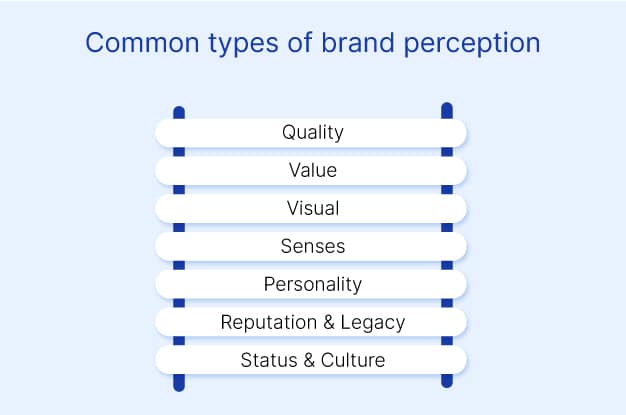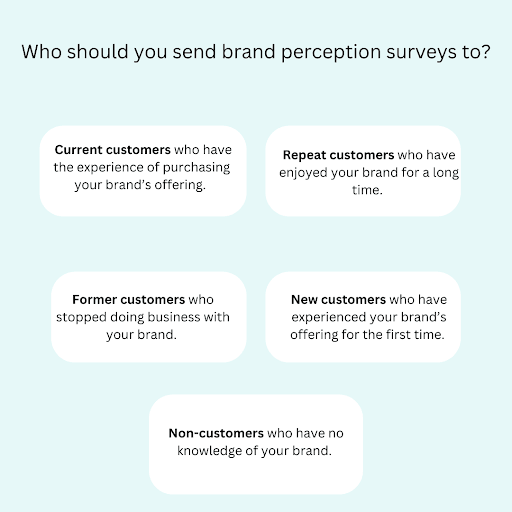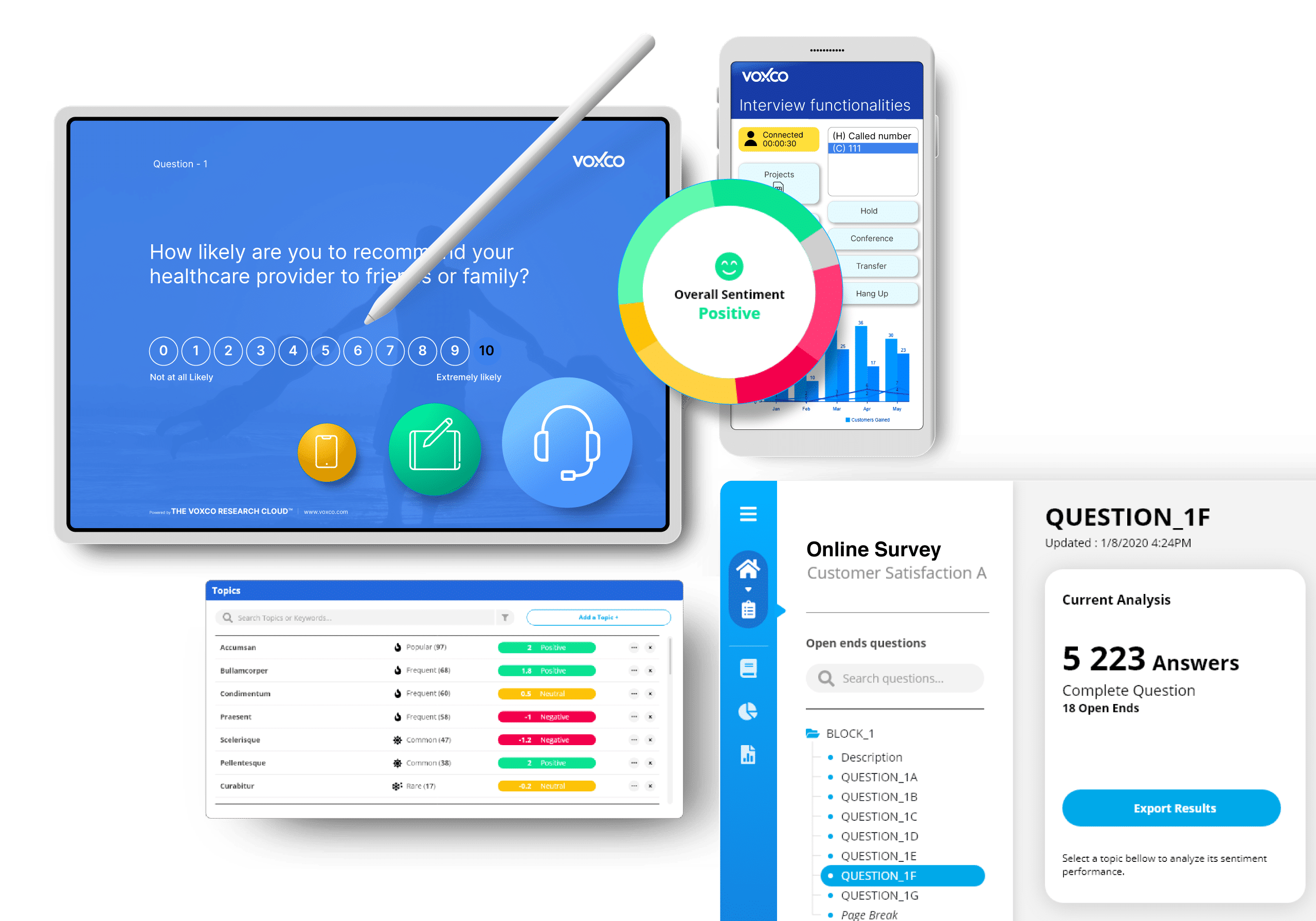Unveiling The Factors That Mold Your Brand Perception
SHARE THE ARTICLE ON

It takes an average of 10 seconds for consumers to form a perception of a brand.
This is how quickly people judge brands. Every second counts when it comes to making the desired brand. But what is customer perception?
Although the term “customer perception” is a fairly self-explanatory branding term on the face of it, which essentially means the perception of your brand in the market, only a few understand the art of shaping that perception to lead a brand to success.
In this article, we’ll discuss what customer perception is, its importance, the different ways to monitor and measure brand perception, and what you can do to improve or shift your brand’s perception in the mind of your audience.
What is brand perception?

The brand image of Nike is different from other apparel brands. It is considered a premium, cult brand that deals only in sportswear. Nike consumers perceive the brand as one that deals only in sportswear.
This is an example of what a customer perception is.
However, a lot of times, brand owners feel they understand exactly what their brand represents but utterly fail at figuring out the actual perception of the audience.
Brand perception is owned by consumers, not brands. Regardless of what image you aim to represent for your brand, your brand perception will be defined by what people think your product or service represents.
See how this sample survey helps you measure brand perception.
What is a brand perception survey?
A brand perception survey is a strategic tool utilized by businesses to gauge how the target audience perceives their brand. It involves collecting valuable insights and opinions from customers, stakeholders, and the general public to understand the image, values, and reputation associated with the brand.
In essence, a brand perception survey delves into the minds of consumers, allowing companies to comprehend how their products, services, and messaging are resonating with the intended market. This survey typically encompasses a series of well-crafted questions that touch upon various aspects of the brand, aiming to capture both quantitative and qualitative data.
Why does brand perception matter?
Do you know people are far more likely to share negative brand experiences with their friends and family than positive brand experiences? Over 50% more likely, according to a report published by MarketingCharts.
What is customer perception if it doesn’t impact your customers’ decision to choose your product or service, do business with you, or recommend your brand to others, or dissuade them entirely?
Brand perception can impact your bottom line to a great extent.
In today’s hyper-competitive marketplace, brand perceptions or customer opinions matter a lot just like your customers do.
Tracking and understanding customer perceptions gives you an opportunity to shift and elevate these perceptions. It’s an essential part of brand reputation management.

Believing your brand perception to be more positive than it actually is won’t help yield results. An honest look at the factors driving or killing your brand loyalty will. This is why brand perception is so important in building your business and leading it to success.
What is the Importance of a brand perception survey?
Brands often assume they know how their customers feel about them. Based on customer interactions alone, brands tend to magnify brand perception. But this is not what brand perception is.
Understanding the significance of a brand perception survey is paramount in today’s competitive business landscape.
1. Insight into customer sentiment:
A brand perception survey provides a direct avenue to grasp how customers truly feel about your brand. It helps uncover sentiments, preferences, and pain points, enabling you to tailor your strategies accordingly.
2. Strategic decision making:
Informed decisions are the cornerstone of success. By gathering data through a perception survey, you equip yourself with the necessary information to make strategic moves that align with the market’s perceptions and expectations.
3. Adaptation and improvement:
Markets evolve, and so should brands. By regularly conducting perception surveys, you stay attuned to changing trends, allowing you to adapt your brand image and offerings proactively.
4. Competitive edge:
In a world inundated with options, standing out is imperative. A brand perception survey lets you identify what sets you apart from competitors, aiding in refining your unique value proposition.
5. Reputation management:
Your brand’s reputation is fragile and immensely valuable. A perception survey helps you identify potential reputation risks early on, enabling effective damage control and fostering trust.
A brand perception survey is a powerful tool that helps you align your brand with the perception, belief, and emotion of your target audience by fueling data-driven decisions.
Brand perception survey questions to ask your customers
Surveys can get you very detailed and honest insights into what your brand’s customer perception is, provided you frame the right kind of questions.
It all comes down to the kind of questions that can best get you to the insights you need to shape and enhance your brand perception.
Here are four factors that your questions should focus on to understand how customers perceive your brand.
1. Cognitive: The concept that customers associate
- When you think of our brand, what comes to your mind first?
- What words would you use to describe our brand? Choose from the list.
- How do you feel about each word you have chosen on a scale of 0 to 7?
2. Emotional: The feelings they associate
- What emotions/feelings do you experience when you think about our brand?
- (Positive/negative scale) How would you define the emotional attachment you feel towards our brand?
- Describe a memorable experience you’ve had with our brand.
3. Language: How customers understand & describe your brand
- What words would you use to describe our brand to a friend?
- Do you find our brand’s messaging easy to grasp?
- Which words would you use to describe the personality of our brand?
4. Action: The experience customers have with your brand
- How would you describe your recent experience with our brand?
- (Scale of 0 to 10) How likely are you to buy the newest product from our brand?
- Rate your overall satisfaction with your last buying experience.
If you’re running short on ideas, consider using these types of questions in your brand perception survey:
Net Promoter Score (NPS ) questions:
- How likely are they to recommend your brand to a friend, colleague, or family member?
- Why or why not? (Take a quick look at this recent blog post that includes detailed NPS questions in your customer satisfaction surveys)
- What’s the one thing we could do to make your experience better?
Ability to meet expectations:
- Did your most recent experience or interaction with our brand meet or exceed your expectations?
- What did you like least about the product or service?
Brand Image:
- Has your most recent experience enhanced your view of our brand? In what way and why?
- Do you rate our brand highly in specific attributes and poorly in others, and how?
Be sure to include follow-up questions to dig further into your customer feedback and power your research.
- 100+ question types
- Advanced logic
- White-label
- Auto-translations in 100+ languages
How to measure brand perception?
A study on brand recognition statistics by JAMA Network discovered that 91.3% of 6-year-olds could match Old Joe’s image with a picture of a cigarette in 1991.
This demonstrates just how early brand name recognition and perception starts.
Although brand perception can be very difficult to quantify without the right tools in hand, it is, after all, what affects your brand visibility and marketing success.
Here are some of the most efficient ways of monitoring and measuring your brand perception:
1. Send out customer surveys
Surveys prove to be one of the most efficient ways to gather targeted and detailed insights from your consumers to better understand how they perceive your brand and the key drivers of these perceptions. These valuable first-party insights will help you dig deeper into what your brand’s consumers’ perceptions are and boost them by making strategic CX decisions.
2. Monitor social media
Today, social media is the most popular place where people share their opinions and experiences.
Keep a close watch on the different social media platforms out there, including Facebook, Instagram, Twitter, Linkedin, Pinterest, and Reddit, among others. Your aim should be to catch the latest trends and see how people’s opinions shift around certain keywords or topics.
Consider performing a sentiment analysis for this. Track the mentions of your brand.
3. Keep an eye on review sites
Customer and employee reviews will help you stay on top of what your customer perception is and how your brand is being mentioned and discussed online rather than on social media. Keep an eye on public online forums, customer review sites (like Amazon customer reviews and Google Places), blogs, and news sites for mentions of your brand.
4. Maintain an active email list
Reach out to your target audience regularly via emails to know what they think about your brand. This is probably the most straightforward way and often not very effective to get the lowdown from the horse’s mouth.
Who should you send the brand perception survey to?

Many companies think they should only try to understand the brand perception of their existing customers. While it is important and proper to gather valuable insights, you should also focus on customers who decided they don’t enjoy using your brand and stopped any interaction.
The churned customers can provide unfiltered, genuine, and valuable insights because something about their experience has pushed them to stop doing business with your brand. Most importantly, if these people are in the range of your target audience, this can give you clear insights into what you must improve and resolve.
Curious About The Price? Click Below To Get A Personalized Quote.
How to improve brand perception?
Once you’ve developed what you believe is a great product or service and unleashed it to your audience, you will start receiving reviews on your social media channels. Reviews that are both positive and negative.
But there’s no point in feeling baffled about them.
The real verdict lies with your customers and their perception of your brand. That will ultimately decide whether your business will take off or break down.
Here are some tips to put you on the right track to improve your customer perception and increase brand loyalty:
1. Identify your audience and understand their perception of your brand
This goes beyond having a dry notion of surface-level customer details such as age, gender, demographics, and language. To get the answer of what your customer perception is, you need to analyze your customer behaviors, such as how they consume information and what drives them to choose you over your competitors.
You do not need a huge marketing budget to understand what your customers’ perception is. Omnichannel survey software proves to be the quickest and most efficient tool for capturing their perception.
2. Develop and maintain a positive connection with your customers
Tons of studies have shown how customers who have had the best and most personalized experiences with a brand spend over 100% more money compared to those who have had the poorest interactions. Apart from improved profitability, positive customer-business relationships can directly influence how your consumers perceive your brand.
3. Be open to feedback and strive to improve
It just can’t be stressed enough how important it is not to ignore the negative criticism from your clients. Be open to receiving both positive and negative customer feedback. When it comes to collecting customer feedback, some of the best options include surveys and polls.
Like any other perception, brand perception, too, doesn’t change overnight. Be prepared to research and take the necessary steps to improve how your consumers perceive you.
See how Voxco can enhance your research efficiency.
Conclusion
Do you think you know what your brand’s customer perception is or what it represents?
Before you nod, remember that brand perception is not what you say in your advertisements.
It is what consumers think and say you are.
Regardless of the message you transmit, it’s important that your audience receives it the way you intended them to. Otherwise, it’s null and void.
Navigating the realm of brand perception is a dynamic and multi-faceted journey that demands careful consideration. Once you have insights into your customer needs and motivations, you can devise strategies to shift and improve your brand perception among them.
Ready to improve your customers’ perception of your brand? Start off on the right foot with the world’s leading omnichannel survey software out there.
Read more

Net Promoter Score Program
Net PromoterScore® Program Net Promoter Score® Hub See what question types are possible with a sample survey! Try a Sample Survey Table of Contents 01

Voxco rolls out an exciting new feature & several updates.
Voxco rolls out an exciting new feature & several updates. Updates include enhancements, which are an extension of the features Voxco launched at the beginning

Social Research : A complete guide
Social Research : A complete guide SHARE THE ARTICLE ON Share on facebook Share on twitter Share on linkedin Table of Contents What is social

Why is Market Segmentation Important?
Conducting research studies can be intense! Surveys, analytics, data verification, and monitoring. One of the most rewarding parts of research is when you get to showcase your survey results to your stakeholders.

Elevating Customer Experience with CATI
Customer experience is in the spotlight for most companies these days and for good reason – It is the final piece of the equation which

Patient Journey Mapping
Patient Journey Mapping SHARE THE ARTICLE ON See what question types are possible with a sample survey! Try a Sample Survey Table of Contents Patient




 English
English French
French

